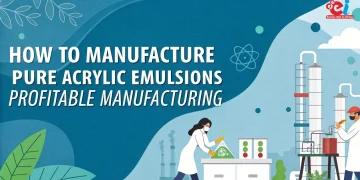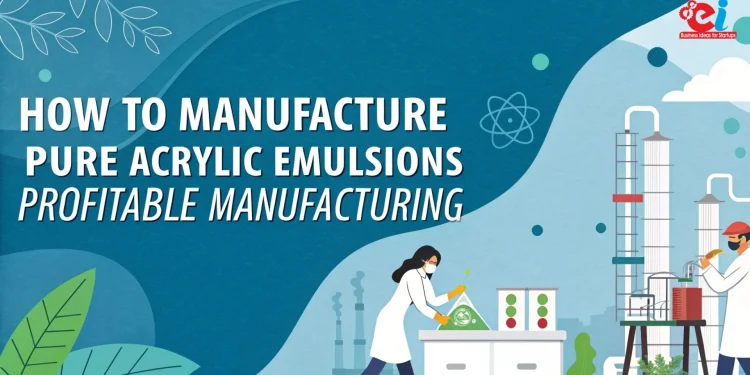With respect to modern coatings and construction chemicals, Pure Acrylic Emulsions polymers are durable solutions and are environmentally friendly. Unlike blended or modified systems, pure acrylic polymers are made from 100% acrylic monomers, which ensure unmatched weather resistance, UV stability, flexibility, and chemical inertness. These attributes make them indispensable in exterior paints, elastomeric coatings, finishes for textiles, pressure-sensitive adhesives, and waterproofing systems.
In both developed and developing countries, regulations pertaining to VOCs, sustainable development, and their ecological impact have led to an increase in the water-based emulsion paints market, directly accelerating the adoption of eco-friendly chemistry in the country. In India, the market is now rapidly expanding in the decorative paints segment, driven by the advancements in construction infrastructure, investment in decorative paints, and adoption of ecologically preferred chemistry.
NPCS (NIIR Project Consultancy Services) is a leading industrial consulting firm that is catalyzing this transformation. The firm aids chemical formulators and entrepreneurs in stepping into this lucrative market by crafting detailed project reports which include production granting financial estimates, market positioning and strategy for pure acrylic polymers, process workflows, tailored building blocks, and a flexible infrastructure design.
New Developments for Case Polymers
Acrylic emulsions are in demand all over the world, and for good reason; their use is expected to grow by more than 6% CAGR, with the 100% acrylic polymer segment outperforming competition enjoying wider acceptance than styrene-acrylic or vinyl-acrylic counterparts. In India, the government’s ‘affordable housing’ and ‘smart city’ initiatives alongside construction eco-friendly materials also translates to waterproofing require durable exterior paints. Polyacrylates are considered the most efficient selection because of the breathability, alkali resistance, and superior adhesion to polyacrylate seams.
In addition, acrylic elastomers chambers expand beyond paints to include textile coatings, laminating adhesives, engineering plastics for automotive, and high performance sealants. These systems are preferred by formulators for shelf-life and stability and pigment and specialty additive compatibility.
As NIIR Project and Consultancy Services reports, there has been a remarkable increase in inquiries for the plants that produces water based emulsions with low vocs from Southeast Asia and India.
Understanding the Production Process of Pure Acrylic Polymers
Acrylic Emulsions are formed from such monomers as butyl acrylate (BA), methyl methacrylate (MMA), ethyl acrylate (EA), and 2-ethylhexyl acrylate (2-EHA). BA and 2-EHA are flexible while MMA toughens and weatherproofs the polymers.
The glass transition temperature (Tg) of a Polymer can be affected by the proportion of hard and soft monomers. For instance, lower Tg is favorable in elastomeric coatings while higher Tg is advantageous when used as hard binders in architectural coatings.
In making pure acrylics, styrene or vinyl parts must not be incorporated. This increases yellowing stability and UV resistance thus increasing durability for exterior applications. More complex designs may contain functional monomers such as HEA used for crosslinking, AA for wet adhesion, and MAA to enhance dispersion stability.
Of greater significance is the absence of co-monomer “contamination” which means greater compatibility with eco-friendly performance additives and surfactants used in water-based systems.
Related: Styrene Acrylic Emulsion: Profitable Uses, Process & ROI Insights
Manufacturing Process of Pure Acrylic Emulsions
The production of pure acrylic emulsions begins with emulsion polymerization processes of acrylate emulsions. These processes have been refined to control factors like molecular weight, particle size, and the viscosity of the final dispersion. This technique involves free radical polymerization of acrylic monomers, surfactants, buffers, as well as chain transfer agents, and is water based.
The first steps involve creating a specific pre-emulsion. Surfactants, monomers, and water are blended through high shear emulsifiers. The pre-emulsion is also fed into a jacketed stainless steel reactor maintained at low pressures (< 1.0 bar) for total oxygen exclusion. This ensures no inhibition of free radical reactions.
Initiators for the reaction include ammonium persulfate (APS) or potassium persulfate (KPS). Optimal heating, stirring, and temperature control (70-85°C) allows for consistent reaction. It is possible to alter strategies such as batch, semi-batch, or continuous feed depending on product requirements. Semi-batch is often preferred for heat control and product consistency.
For functionalized acrylic emulsions, MAA or HEA seem to be included as end-blockers to manage surface energy and allow further crosslinking in subsequent stages. The process is halted when all the monomers are consumed. This is followed by the cooling, pH adjustment (neutralization), filtration, and checking different specifications.
In combination with controlled pH feed zones, monopropylene glycol is used post-polymerization to precisely remove unwanted monomers at designated concentration feed zones and pH-regulated zones as well as in-reactor viscosity control systems ensuring batch to batch uniformity in quality.
Key Equipment Needed for Its Production
To establish an Acrylic emulsions plant for pure acrylic polymer, one requires a set of chemical reactors, emulsification units, monitoring and control systems for heating and cooling, as well as testing equipment of the plant.
The first component is the polymerization reactor which is often made of SS316L, with a capacity ranging from 1,000 to 10,000 liters depending on the scale of production.
The equipment is made up of:
- Systems for recovering monomers and apparatus for breaking emulsions under vacuum
- Vessels for blending pre-emulsions with high-speed mixers
- Metallization pumps for the dosing of monomers and initiators
- Purging systems using nitrogen
- Steam boilers alongside heat exchangers meant for the regulation of temperatures
- Circulating chilled water units as well as cooling towers
- Homogenizers with inline configuration used for the control of particle sizes
- Units for the removal of coagulum filtration
- Automation of processes is done through digital control panels (PLC/SCADA)
From the perspective of safety, the following are crucial: adequate zoning segregation for monomer storage areas, explosion-proof electrical fittings, monitored zones for the handling of chemicals that are classified as hazardous, and safes zones where handling of critical chemicals can be conducted.
Nigeria-based consultancy service specializes in project planning in terms of construction and fabrication works selected capacities of plants.
Related: How to Start an Acrylic Polymers Manufacturing Business
Raw Materials and Supply Chain Management
The primary components required to manufacture pure acrylic Emulsions polymers are:
- Acrylic Monomers: Methyl methacrylate (MMA), Butyl acrylate (BA), Ethyl acrylate (EA), 2-Ethylhexyl acrylate (2-EHA)
- Functional Monomers: Acrylic acid (AA), Methacrylic acid (MAA), Hydroxyethyl acrylate (HEA)
- Initiators: APS, KPS, and redox initiator systems
- Surfactants: APEO-Free Non-Ionic and Anionic Emulsifiers
- Buffers and pH Adjusters: Sodium Bicarbonate, Ammonia, Triethanolamine
- Deionized Water
India globally sources most acrylic monomers from domestic and petrochemical imports. For precise monomer supply and price requirements, closely-held vendor relationships are essential. Surfactant APE-based alternatives present opportunities leading to APE-free nonionic and anionic emulsifiers.
NPCS adds these mounting criteria for vendor selection, import substitution, and procurement strategies in their consulting reports.
Land, Utility and Infrastructure Requirements
For a medium scale unit having an annual capacity of 2,000 MT, an area of approximately 1.5 to 2 acres is needed. In this case, the workstation will be comprised of the production units, raw material warehouses, QC labs, administration blocks, utility areas, as well as the effluent treatment systems.
The resource demanding units, such as mixers, chillers, and boilers, have a combined power demand of 250 kVA – 500 kVA. Steam boilers and chilled water units are essential for maintaining reaction temperature profiles. While water consumption is low, it is critical to soften or demineralize water to avoid ion contamination.
Effluent treatment systems are needed for washing, polymer slurry removal, and clearing residues from reactors. Environmental policies have fueled the adoption of Zero-Liquid Discharge (ZLD) designs. Due to flammable acrylic monomers, fire safety and emergency containment systems are mandatory.
Clients receive from NIIR database comprehensive planning for statutory clearance checklists, building safety zones, and detailed building layouts.
Environmental Policy and Regulatory Approvals
The procedures required by the local and central government bodies for setting up and operating a polymer emulsion manufacturing unit in India are quite cumbersome. The approvals needed include:
- SPCB granting Consent to Establish and Operate
- Operating License (Factory License) under the Factories Act
- Local Government Fire Safety and NOC
- Hazardous waste disposal plan
- License for Storage of Explosives and Dangerous Chemicals (if applicable as per thresholds)
- Environmental clearance for emissions to air and water
For certain architectural paints and adhesives, BIS certification is mandatory. For other products which shall be sold directly to institutions or exported, holding ISO 9001, ISO 14001, ISO 45001 certifications are preferable.
Clients of NIIR are provided help in preparing compliances, filings, application documents, and audit checks with the relevant policy devising bodies.
NIIR Project Consultancy Services: Your Partner in Success
NIIR Project Consultancy Services is well-known for preparing techno-economic feasibility reports and market studies for the chemical, polymer, and emulsion-based manufacturing units. For the pure acrylic polymer projects, NPCS offers:
- Detailed Customized Project Reports (DPRs)
- Market Demand & Competition Analysis
- Selection of Process Technology
- Planning of Raw Materials and Cost Estimation
- Financial Engineering & Loan Structuring
- Plant Layout and Machinery List with Procurement Contacts
- Environmental & Safety Management Compliance Support
Conclusion
The specialty chemicals industry is undergoing a transformative shift driven by advancements in high-performance, eco-compliant water-based polymers. Leading this change are pure acrylic polymers, unmatched in versatility, longevity, and environmental safety.
For businesses and entrepreneurs looking to capitalize on this shift, mastery of the manufacturing process, continuous product development, and compliance with regulations are imperative. As a strategic partner, NIIR Project Consultancy Services offers comprehensive advice on all technical, financial, and compliance aspects needed to establish a sustainable production unit for pure acrylic polymers, enabling significant market value creation.


























